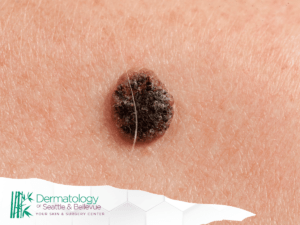Skin cancer is one of the most common cancers in the United States, and patients in Seattle face particular risks due to both genetic factors and environmental exposure. When a suspicious spot is diagnosed, many people wonder about the safest and most effective way to treat it. That’s where Mohs surgery comes in. This comprehensive guide will help Seattle patients understand what Mohs surgery is, how it works, and what to expect before, during, and after the procedure.
What Is Mohs Surgery?
Mohs surgery, also called Mohs micrographic surgery, is a highly specialized skin cancer surgery designed to remove cancerous cells layer by layer while preserving as much healthy tissue as possible. Developed by Dr. Frederic Mohs, the technique combines surgical precision with immediate microscopic examination, ensuring the complete removal of cancer with minimal impact on surrounding skin.
Why It’s Considered The Gold Standard
Mohs is considered the gold standard for treating common skin cancers such as basal cell carcinoma and squamous cell carcinoma. Its effectiveness lies in its high cure rate and its ability to minimize the removal of healthy skin. This precision makes it especially valuable for cancers on sensitive areas like the nose, ears, or eyelids.
Key advantages include:
- Highest cure rate among skin cancer treatments
- Tissue preservation, which reduces scarring
- Immediate results since tissue is examined during the surgery
Understanding Skin Cancer
Skin cancer develops when abnormal cells grow uncontrollably in the skin. While some cancers are less aggressive, others can spread quickly if not treated early. Understanding the different types helps patients see why Mohs surgery is often chosen as a primary treatment.
Common Skin Cancers
The most common skin cancers include:
- Basal cell carcinoma (BCC): Usually slow-growing and rarely spreads, but can cause extensive local damage if untreated.
- Squamous cell carcinoma (SCC): Can spread deeper into tissues or nearby lymph nodes if ignored.
- Melanoma: Less common but more dangerous because it can spread rapidly to other organs.
Basal Cell Carcinoma And Squamous Cell Carcinoma
Basal cell carcinoma and squamous cell carcinoma are the two main types treated with Mohs surgery. Both are classified as non-melanoma skin cancers, but they behave differently:
- Basal cell carcinoma often looks like a pearly bump or a pinkish patch of skin.
- Squamous cell carcinoma may appear as a scaly patch, sore, or wart-like growth.
Because these cancers tend to occur on sun-exposed areas such as the face, ears, or nose, Mohs surgery offers an excellent balance of complete removal with the best cosmetic outcome.
Why Mohs Surgery Matters In Seattle
Seattle’s climate may be cloudy much of the year, but that doesn’t mean residents are safe from UV damage. Harmful rays still penetrate cloud cover, and many locals spend time outdoors hiking, boating, or skiing in nearby mountains. This lifestyle, combined with fair skin types that are more sensitive to sun exposure, contributes to a steady number of skin cancer cases.
Sun Exposure And Skin Risks
Even in the Pacific Northwest, cumulative sun exposure plays a major role in the development of basal cell and squamous cell carcinomas. Reflection from water and snow can intensify UV rays, increasing risks for outdoor enthusiasts. That’s why dermatologists in Seattle often stress prevention strategies, including regular sunscreen use and protective clothing, alongside routine skin checks.
How The Procedure Works
Mohs surgery is a careful, step-by-step process designed for accuracy. It removes cancer cells while leaving the surrounding healthy tissue intact. The procedure is performed in stages, each followed by microscopic examination of the removed layer. This allows the surgeon to track the cancer’s exact borders until it is fully cleared.
Step-By-Step Process
During Mohs surgery, patients can expect a series of precise steps:
- Local anesthesia is applied to numb the surgical site.
- Layer removal begins, with the surgeon excising a thin layer of skin.
- Microscopic analysis is done immediately in an on-site lab.
- Mapping and tracking ensure that only cancerous tissue is targeted.
- Repeated layers are removed until no cancer cells remain.
This method gives patients peace of mind, knowing the cancer is gone before leaving the office.
Role Of The Mohs Surgeon
The Mohs surgeon serves both as surgeon and pathologist during the procedure. They carefully remove tissue, analyze it under a microscope, and make decisions about where to continue. This dual role is what sets Mohs apart from other forms of skin cancer surgery, where pathology results may take days and require a separate appointment.
Cure Rate And Advantages
Mohs surgery has the highest cure rate of any skin cancer treatment — often up to 99% for basal cell carcinoma and squamous cell carcinoma when detected early. Beyond effectiveness, patients benefit from:
- Smaller surgical wounds
- Reduced need for reconstruction
- Better cosmetic outcomes, especially on visible areas like the nose or eyelids
These advantages explain why Mohs is often recommended by dermatologists for cancers in delicate or cosmetically sensitive areas.
Preparing For Surgery
Getting ready for Mohs surgery involves more than just showing up on the day of the procedure. Patients in Seattle are encouraged to plan ahead, follow instructions from their care team, and prepare for the possibility that the surgery may take several hours depending on how many layers need to be removed.
Surgery Consultation And Planning
Before the procedure, patients meet with their dermatologist or Mohs surgeon for a thorough consultation. This includes reviewing medical history, discussing medications, and talking about the type of skin cancer being treated. The surgery consultation is also the time to learn about wound care, healing expectations, and any reconstruction that may be necessary.
Questions To Ask Your Skin Cancer Care Team
Patients often feel more at ease when they know what to expect. Helpful questions include:
- How many Mohs surgeries does this surgeon perform each year?
- What are the risks of this procedure for my type of skin cancer?
- What will wound care involve afterward?
- Will reconstruction be needed at the surgical site?
Being informed helps patients feel confident in their treatment plan.
The Day Of Surgery
On the day of surgery, patients arrive early and should be prepared to spend several hours at the clinic. Because the procedure is performed in stages with microscopic review between each layer, the length of time varies from person to person. Some may finish within a few hours, while others require most of the day.
What Patients Can Expect
After check-in, the surgical site is cleaned and numbed with local anesthesia. Patients remain awake throughout the procedure but should not feel pain. A small layer of skin is removed and taken to the lab for immediate analysis. Between stages, patients wait comfortably while results are processed. Once the surgeon confirms that all cancer cells are gone, the wound is either closed with stitches or left to heal naturally, depending on its size and location.
Recovery And Healing
Recovery after Mohs surgery varies but is usually straightforward. Most patients experience mild discomfort, swelling, or bruising for the first few days. Healing times depend on the size of the wound and whether stitches or reconstruction are required. Careful follow-up helps ensure the surgical site heals properly and reduces the risk of complications.
Wound Care And Healing Tips
Proper wound care is critical to recovery. Patients are usually given written instructions on how to clean the area, apply ointment, and change dressings. Following these directions helps prevent infection and promotes faster healing.
Key wound care tips include:
- Keep the surgical site clean and dry as advised
- Apply antibiotic ointment if recommended
- Change bandages regularly with clean hands
- Watch for signs of infection such as redness, swelling, or unusual drainage
Managing The Surgical Site
The surgical site may feel tender or tight for several days. Patients should avoid strenuous activity that could stretch the wound, especially if it’s located near the nose, eyes, or mouth. Cold compresses can help with swelling, and over-the-counter pain relievers are usually sufficient for discomfort.
Long-Term Recovery And Sun Protection
Healing continues over weeks to months, depending on wound size. Scars gradually fade, and many patients find them barely noticeable after a year. Long-term care involves regular skin checks and ongoing sun protection to reduce the risk of future skin cancers. Dermatologists recommend daily use of broad-spectrum sunscreen, wearing protective hats, and scheduling follow-up visits to monitor for new growths.
Other Treatment Options
While Mohs surgery is often the preferred method for treating non-melanoma skin cancers, it isn’t the only approach. Depending on the type of skin cancer, its size, and location, doctors may recommend other treatment options to ensure complete care. These alternatives are usually considered for patients who aren’t ideal candidates for surgery or when cancer requires a combined approach.
Radiation Therapy
Radiation therapy may be used when surgery is not possible, such as for patients with certain health conditions or cancers located in difficult areas. It involves directing controlled doses of radiation at the tumor to destroy cancer cells. While effective, radiation therapy can require multiple sessions and may carry side effects such as skin irritation or long-term tissue changes.
Topical Chemotherapy
For very superficial types of skin cancer, topical chemotherapy creams may be prescribed. These medications are applied directly to the skin, targeting cancer cells without affecting the rest of the body. Although not as effective for deeper cancers, topical treatments can be useful for smaller, early-stage lesions and may complement other methods of skin cancer treatment.
Cancer Care Resources In Seattle
Seattle patients have access to some of the nation’s leading cancer care facilities. From university-affiliated hospitals to private dermatology practices, the city offers a wide range of options for diagnosis, surgery, and long-term follow-up. Having access to these resources ensures patients receive comprehensive skin cancer care tailored to their individual needs.
Conclusion
Mohs surgery explained: A Seattle patient’s guide to skin cancer removal shows why this treatment is trusted as the gold standard for many common skin cancers. With its unmatched cure rate, tissue-preserving technique, and ability to minimize scarring, Mohs offers patients both effective cancer removal and peace of mind. For those in Seattle, access to skilled dermatologists, Mohs surgeons, and leading institutions like Dermatology of Seattle means comprehensive skin cancer care is close at hand. Whether dealing with basal cell carcinoma, squamous cell carcinoma, or another type of skin cancer, understanding the procedure, preparation, and recovery can help patients approach surgery with confidence.
Disclaimer
This article is intended for educational purposes only and should not be taken as medical advice. Every case of skin cancer is unique, and treatment decisions should always be made in consultation with a qualified dermatologist or cancer care specialist. If you notice suspicious changes in your skin or have concerns about treatment options, schedule an appointment with a licensed healthcare provider.




